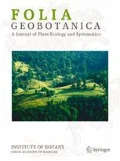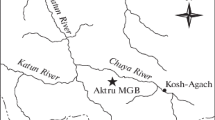Abstract
The primary successional sere of a warm-temperate forest was inferred from an age sequence of four basaltic volcanic substrates (16-, 37- and 125-yr-old lava flows, and volcanic ejecta older than 800 years) at several altitudes (ranging from 30 to 550 m) on Miyake-jima Island. The DCA analysis of species composition indicated that the vegetation is patterned by substrate age and altitude. The vegetation successionally changed fromAlnus sieboldiana shrub, toMachilus thunbergii andPrunus speciosa forest, toCastanopsis sieboldii forest at all altitudes. The rate of succession seems to be slower at higher altitudes. The above-ground biomass was 20 kg/m2 (160 m a.s.l.) and 12 kg/m2 (300 m a.s.l.) on the 125-yr-old lava flow, and 54 kg/m2 (100 m a.s.l.) and 16 kg/m2 (350 m a.s.l.) on the old ejecta. However, the large difference of above-ground biomass between low versus high altitudes on the old ejecta might not only reflect climatic differences but also past human disturbances at the higher altitude. In spite of the colder climate of Miyake-jima the rate of above-ground biomass accumulation here was considerably faster than that of a Hawaiian montane tropical evergreen forest on the same basaltic lava substrate. We suggest that the faster above-ground biomass development is due to the facilitation effects of N-fixation byAlnus. The inorganic N soil concentration was extremely high on the 37- and 125-yr-old lava flows whereAlnus was dominant. The foliar N concentration inAlnus was 2% irrespective of substrate age. The deposition of N fromAlnus via litterfall would decrease the soil C/N ratio, which in turn facilitates net soil N mineralization and consequently provides an ample supply of inorganic N to plants. N limitation on vegetation development, which is prevalent during the early stage of succession on volcanic lava flows or similar substrates elsewhere, is thus alleviated.
Similar content being viewed by others
References
Aplet H.A. &Vitousek P.M. (1994): An age-altitude matrix analysis of Hawaiian rain-forest succession.J. Ecol. 82:137–147.
Atkinson I.A.E. (1970): Successional trends in the coastal and lowland forest of Mauna Loa and Kilauea volcanoes, Hawaii.Pacific Sci. 14: 387–400.
Bormann B.T. &Sidle R.C. (1990): Changes in productivity and distribution of nutrients in a chronosequence at Glacier Bay National Park, Alaska.J. Ecol. 78: 561–578.
Chapin F.S., IIIWalker L.R., Fastie C.L. &Sharman L.C. (1994): Mechanisms of primary succession following deglaciation at Glacier Bay, Alaska.Ecol. Monogr. 64: 149–175.
Clements F.E. (1916):Plant succession. Carnegie Institute, Washington.
Crews T.E., Kitayama K., Fownes J.H., Riley R.H., Herbert D. A., Mueller-Dombois D. &Vitousek P.M. (1995): Changes in soil phosphorus fractions and ecosystem dynamics across a long chronosequence in Hawaii.Ecology 76: 1407–1424.
del Moral R. &Bliss L.C. (1993): Mechanisms of primary succession: Insight resulting from the eruption of Mount St Helens.Advances Ecol. Res. 24: 1–66.
Drake D.R. &Muller-Dombois D. (1993): Population development of rain forest trees on a chronosequence of Hawaiian lava flows.Ecology 74: 1012–1019.
Edwards J.S. &Sugg P. (1993): Arthropod fallout as a resource in the recolonization of Mount St. Helens.Ecology 74: 954–958.
Eggler W. (1971): Quantitative studies of vegetation on sixteen young lava flows on the island of Hawaii.Trop. Ecol. 12: 66–100.
Environmental Agency (ed.) (1988):Important plant communities of Japan II. Printing Bureau, University of Finance, Tokyo (In Japanese).
Fritz-Sheridan R. (1987): Nitrogen fixation on the tropical volcano La Soufriere (Guadeloupe): I. a survey of nitrogen fixation by blue-green algal microepiphytes and lichen endophytes.Biotropica 19: 194–199.
Geographical Survey Institute (1995):Land condition map of Volcano, Miyakezima. Geographical Survey Institute, Tsukuba.
Heanes D.L. (1984): Determination of total organic-C in soils by an improved chromic acid digestion and spectrophotometric procedure.Commun. Soil Sci. Pl. Analysis 15: 1191–1213.
Higuchi H. (1976): Ecological significance of the larger body sizes in an island subspecies of the Varied Tit,Parus varius.Proc. Jap. Soc. Syst. Zool. 12: 78–86.
Hill M.O. (1979):DECORANA: a fortran program for detrended correspondence analysis and reciprocal averaging. Ecological and Systematics Department, Cornell University, New York.
Hiroki S. &Ichino K. (1993) Difference of invasion behavior between two climax species,Castanopsis cuspidata var.sieboldii andMachilus thunbergii, on lava flows on Miyakejima.Jap. Ecol. Res. 8: 167–172.
Isshiki N. (1960):Geology of Miyake-jima district. Geological Survey of Japan, Tokyo (In Japanese with English summary).
Isshiki N. (1984): Activity of Miyakejima Volcano during the last 3000 years.Rep. Coodinating Committee Prediction Volcanic Eruption 29: 1–3 (In Japanese).
Iwatsuki K. (ed.) (1992):Ferns and fern allies of Japan. Heibonsha, Tokyo (In Japanese).
Kamijo T. (1997): Regeneration process ofCastanopsis andPersea forest on Miyake-jima Island, the Izu Islands.Jap. J. Ecol. 47: 1–17 (In Japanese with English summary).
Kamijo T. &Okutomi K. (1993): Distribution ofCastanopsis forest andPersea forest and its causal factors on Hachijo-jima, in the Izu Islands.Jap. J. Ecol. 43: 169–179 (In Japanese with English summary).
Kamijo T. &Okutomi K. (1995): Seedling establishment ofCastanopsis cuspidata var.sieboldii andPersea thunbergii on lava and scoria of the 1962 eruption on Miyake-jima Island, the Izu Islands.Ecol. Res. (Tokyo) 10: 235–242.
Kitayama K. (1996): Soil nitrogen dynamics along a gradient of long-term soil development in a Hawaiian wet montane rainforest.Pl. & Soil 183: 253–262.
Kitayama K., Aiba S., Majalap-Lee N. &Ohsawa M. (1998): Soil nitrogen mineralization rates of rainforests in a matrix of elevations and geological substrates on Mount Kinabalu, Borneo.Ecol. Res. (Tokyo) 13: 301–312.
Kitayama K. &Mueller-Dombois D. (1995): Vegetation changes along gradients of long-term soil development in the Hawaiian montane rainforest zone.Vegetatio 120: 1–20.
Kitayama K., Mueller-Dombois D. &Vitousek P.M. (1995): Primary succession of Hawaiian montane rain forest on a chronosequence of eight lava flow.J. Veg. Sci. 6: 211–222.
Kitayama K., Shuur E.A. G., Drake D.R. &Mueller-Dombois D. (1997) Fate of a wet montane forest during soil ageing in Hawaii.J. Ecol. 85: 669–679.
Kusumoto T. (1957): Physiological and ecological studies on the plant production in plant communities: 4. Ecological studies on the apparent photosynthesis curves of evergreen broad-leaved trees.Bot. Mag. (Tokyo) 70: 299–304.
Masuzawa T. (1985): Ecological studies on timberline of Mt. Fuji: I. Structure of plant community and soil development on the timberline.Bot. Mag. (Tokyo) 98: 15–28.
Miyazaki T. (1984): Features of historical eruptions at Miyake-jima Volcano.Bull. Volcanol. Soc. Japan, 2nd Ser. 29: 1–15.
Mueller-Dombois D. &Ellenberg H. (1974):Aims and methods of vegetation ecology. John Wiley & Sons, New York.
Nagano M. (1978): Dynamics of stand development. In:Kira T., Ono Y. &Hosokawa T. (eds.),Biological production in a warm-temperate evergreen oak forest of Japan, JIBP synthesis vol. 18, University of Tokyo Press, Tokyo, pp. 21–32.
Ohsawa M. (1984): Differentiation of vegetation zones and species strategies in the subalpine region of Mt. Fuji.Vegetatio 57: 15–52.
Sakio H. &Masuzawa T. (1992): Ecological studies on timberline of Mt. Fuji: III. Seasonal changes in nitrogen content in leaves of woody plants.Bot. Mag. (Tokyo) 105: 47–52.
Satake Y., Hara H., Watari S. &Tominari T. (eds.) (1989a):Wild flowers of Japan. Woody plants I. Heibonsha, Tokyo (In Japanese).
Satake Y., Hara H., Watari S. &Tominari T. (eds.) (1989b):Wild flowers of Japan. Woody plants II. Heibonsha, Tokyo (In Japanese).
Satake Y., Ohwi J., Kitamura S., Watari S. &Tominari T. (eds.) (1981):Wild flowers of Japan. Herbaceous plants III. Heibonsha, Tokyo (In Japanese).
Satake Y., Ohwi J., Kitamura S., Watari S. &Tominari T. (eds.) (1982a):Wild flowers of Japan. Herbaceous plants I. Heibonsha, Tokyo (In Japanese).
Satake Y., Ohwi J., Kitamura S., Watari S. &Tominari T. (eds.) (1982b):Wild flowers of Japan. Herbaceous plants II. Heibonsha, Tokyo (In Japanese).
Smathers G.A. & Muller-Dombois D. (1974): Invation and recovery of vegetation after a volcanic eruption in Hawaii.Natl. Parks Serv. Sci. Monogr. No. 5: 1–129.
Soya T. &Uto K. (1984): Fissures and eject of the eruption of Oct. 3, 1983, of Miyakejima.Rep. Coodinating Committee Prediction Volcanic Eruption 29: 6–9 (In Japanese).
Tagawa H. (1964): A study of the volcanic vegetation in Sakurajima, south-west Japan: I. dynamics of vegetation.Mem. Fac. Sci. Kyushu Univ., Ser. E, Biol. 3: 165–228.
Takeda H. (1994): Interactions between plant and decomposer populations in forest ecosystems: a mechanism of biodiversity maintenance.Jap. J. Ecol. 44: 211–222. (In Japanese).
Takeda H. (1995): A 5 year study of litter decomposition processes in aChamaecyparis obtusa Endle. forest.Ecol. Res. (Tokyo) 10: 95–104.
Tezuka Y. (1961): Development of vegetation in relation to soil formation in the volcanic island of Ohshima, Izu, Japan.Jap. J. Bot. 17: 371–402.
Tilman D. (1982):Resource competition and community structure. Princeton University Press, Princeton.
Tilman D. (1986): Nitrogen-limited growth in plants from different successional stages.Ecology 67: 555–563.
Tsuyuzaki S. (1991): Species turnover and diversity during early stage of vegetation recovery on the volcano Usu, northern Japan.J. Veg. Sci. 2: 301–306.
Tsuyuzaki S. (1995): Vegetation recovery patterns in early volcanic succession.J. Pl. Sci. Res. 108: 241–248.
Ugolini F.C., Dahlgren R., LaManna J., Nuhn W.W. &Zachara J. (1992): Mineralogy and weathering processes in recent and Holocene tephra deposits of the Pacific Northwest USA.Geoderma 51: 277–299.
Uhe G. (1988): The composition of the plant communities inhabiting the recent volcanic deposits of Maui and Hawaii, Hawaiian Islands.Trop. Ecol. 29: 26–47.
Vitousek P.M. (1994): Potential nitrogen fixation during primary succession in Hawaii Volcanoes National Park.Biotropica 26: 234–240.
Vitousek P.M., Aplet G., Turner D. &Lockwood J.J. (1992): The Mauna Loa environmental matrix: foliar and soil nutrients.Oecologia 89: 372–382.
Vitousek P.M., Matson P.A. &Cleve K.V. (1989): Nitrogen availability and nitrification during succession: primary, secondary, and old field seres.Pl. & Soil 115: 229–239.
Vitousek P.M., Turner D.R. &Kitayama K. (1995): Foliar nutrients during log-term soil development in Hawaiian montane rain forest.Ecology 76: 712–720.
Vitousek P.M. &Walker K. (1987): Colonization, succession and resource availability: ecosystem-level interactions. In:Gray A.J., Crawley M.J. &Edwards P.J. (eds.),Colonization, succession and stability, Blackwell Scientific, Oxford, pp. 207–224.
Vitousek P.M. &Walker K. (1989): Biological invasion by Myrica faya in Hawaii: plant demography, nitrogen fixation, ecosystem effects.Ecol. Monogr. 59: 247–265.
Vitousek P.M., Walker K., Whiteaker L.M., Mueller-Dombois D., Matson P.A. (1987): Biological invasion by Myrica faya alters ecosystem development in Hawaii.Science 238: 802–804.
Walker T.W. &Syers J.K. (1976): The fate of phosphorus during pedogenesis.Geoderma 14: 1–19.
Author information
Authors and Affiliations
Corresponding author
Rights and permissions
About this article
Cite this article
Kamijo, T., Kitayama, K., Sugawara, A. et al. Primary succession of the warm-temperate broad-leaved forest on a volcanic island, Miyake-jima, Japan. Folia Geobot 37, 71–91 (2002). https://doi.org/10.1007/BF02803192
Issue Date:
DOI: https://doi.org/10.1007/BF02803192




